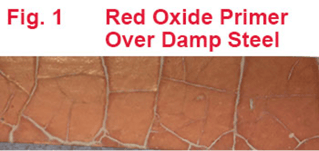When using oil based steel primer, temperature at the time of coating is important. Paint will dry at a slower rate in colder temperatures and its drying solvents can evaporate away before drying is complete, leaving a clay-like film in its place. This is called 'cold curing'.
Temperature is also important when considering the 'dew point' of the environment that primer is being applied. Dew point is the temperature at which naturally existing moisture in the air condenses into water droplets.
No matter what temperature, water molecules are always present in the air. At higher temperatures, the air can accommodate more water molecules than it can at colder temperatures. Once the relative humidity of the environment reaches 100%, any additional water molecules in the air will condense onto any solid surface. The condensation is not always apparent in some cases, and while you may believe that you are applying primer to a perfectly dry surface, these imperceivable water molecules will stop an oil based steel primer from making direct contact with the steel. In this situation, as the steel primer dries and tightens, cracks will occur in the primer coating as shown below in Figure 1.

Water based primers can be used in place of an oil based primer in these circumstance, which may mitigate, but not prevent, the issues related to imperceivable moisture on a steel surface. However, it is important to note that water based primers are more susceptible to cold curing.
If a water based primer is used, it is crucial to ensure that any fabricating, cutting, or drilling oils that are removed from the steel surface. In the same way that even a tiny amount of moisture can prevent a primer from bonding with its surface, these materials can do the same. For example, cold rolled steel, commonly used to produce hand rails, will generally have a very thin layer of oil remaining on it after the milling process, which must be removed before priming.




